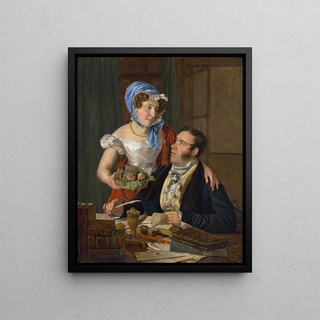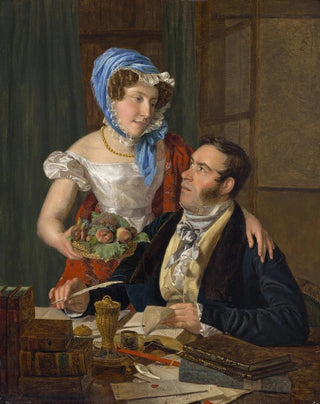Art print of The Cartographer Professor Josef Jöttner and His Wife - Ferdinand Georg Waldmüller | Reproduction


View from behind

Frame (optional)
Reproduction The cartographer professor Josef Jöttner and his wife - Ferdinand Georg Waldmüller – Engaging introduction
In the artistic landscape of the 19th century, Ferdinand Georg Waldmüller's work stands out for its ability to capture the intimacy of human relationships. The art print The cartographer professor Josef Jöttner and his wife immerses us in a frozen moment, where daily life blends with a certain nobility. This painting does not merely depict a couple; it evokes a story, a complicity, and a shared love, all wrapped in an atmosphere of serenity. Waldmüller, through his brush, invites us to explore the subtleties of Austrian bourgeois life while revealing the emotions that animate his characters.
Style and uniqueness of the work
Waldmüller's style is characterized by meticulous attention to detail and a subtle use of light. In this piece, the cartographer and his wife are depicted with a precision that reflects an in-depth observation of human nature. The expressions on their faces, imbued with tenderness and reflection, captivate the viewer and invite them to immerse themselves in their universe. The color palette chosen by the artist, with its warm and earthy tones, creates a welcoming and intimate atmosphere, while the harmonious composition emphasizes the balance between the two figures. Waldmüller excels in the art of visual storytelling, transforming an apparently ordinary scene into a richly meaningful representation, where each element contributes to the whole.
The artist and his influence
Ferdinand Georg Waldmüller, born in 1793 in Vienna, is often regarded as one of the pioneers of realism in painting. His career, marked by a constant search for authenticity, reflects the social and cultural upheavals of his time. Influenced by Romantic currents, he developed a style that combines academic rigor with emotional sensitivity. Waldmüller managed to establish himself in the artistic circles of his era, attracting the attention of Vienna's bourgeoisie, who saw in him an artist capable of translating their aspirations and concerns. His work also paved the way for many contemporary artists, who sought to explore the themes

Matte finish

View from behind

Frame (optional)
Reproduction The cartographer professor Josef Jöttner and his wife - Ferdinand Georg Waldmüller – Engaging introduction
In the artistic landscape of the 19th century, Ferdinand Georg Waldmüller's work stands out for its ability to capture the intimacy of human relationships. The art print The cartographer professor Josef Jöttner and his wife immerses us in a frozen moment, where daily life blends with a certain nobility. This painting does not merely depict a couple; it evokes a story, a complicity, and a shared love, all wrapped in an atmosphere of serenity. Waldmüller, through his brush, invites us to explore the subtleties of Austrian bourgeois life while revealing the emotions that animate his characters.
Style and uniqueness of the work
Waldmüller's style is characterized by meticulous attention to detail and a subtle use of light. In this piece, the cartographer and his wife are depicted with a precision that reflects an in-depth observation of human nature. The expressions on their faces, imbued with tenderness and reflection, captivate the viewer and invite them to immerse themselves in their universe. The color palette chosen by the artist, with its warm and earthy tones, creates a welcoming and intimate atmosphere, while the harmonious composition emphasizes the balance between the two figures. Waldmüller excels in the art of visual storytelling, transforming an apparently ordinary scene into a richly meaningful representation, where each element contributes to the whole.
The artist and his influence
Ferdinand Georg Waldmüller, born in 1793 in Vienna, is often regarded as one of the pioneers of realism in painting. His career, marked by a constant search for authenticity, reflects the social and cultural upheavals of his time. Influenced by Romantic currents, he developed a style that combines academic rigor with emotional sensitivity. Waldmüller managed to establish himself in the artistic circles of his era, attracting the attention of Vienna's bourgeoisie, who saw in him an artist capable of translating their aspirations and concerns. His work also paved the way for many contemporary artists, who sought to explore the themes
12,34 €






